Speak directly to the analyst to clarify any post sales queries you may have.
The breast ultrasound market is rapidly evolving, propelled by advances in diagnostic imaging, AI integration, and adaptive service models. Senior leaders seeking actionable insights will find this report essential for navigating disruption, enhancing operational performance, and capturing emerging opportunities.
Market Snapshot: Breast Ultrasound Market Growth and Outlook
The Breast Ultrasound Market grew from USD 3.19 billion in 2024 to USD 3.54 billion in 2025. It is expected to continue growing at a CAGR of 10.96%, reaching USD 7.33 billion by 2032.
Key growth drivers include clinical adoption fuelled by the need for early, accurate diagnosis and investments in R&D for specialized applications. Increasing emphasis on portable, user-friendly ultrasound devices as well as AI-powered solutions is supporting both established and new entrants in the global landscape. This expansion is influenced by regional shifts in healthcare infrastructure, reimbursement frameworks, and technology access.Scope & Segmentation of the Breast Ultrasound Market
- Product Categories: Accessories and consumables such as imaging gel and sterile covers; equipment including probes and systems; and supporting services spanning installation, maintenance, and training.
- Modalities: Portable cart, trolley-mounted, and handheld units (both battery-powered and tethered) meet the needs of diverse medical environments from large hospitals to remote clinics.
- Technologies: 2D ultrasound, advanced 3D/4D systems, Doppler ultrasound, and elastography empower clinicians with higher-resolution imaging, enhanced lesion characterization, and real-time diagnosis.
- Transducer Types: 3D transducers, curved array, linear array, and phased array designs allow tailored imaging based on clinical requirements and tissue type.
- Applications: Diagnostic procedures addressing lesion characterization, screening, and staging, as well as interventional applications including aspiration, biopsy guidance, and drainage.
- End Users: Ambulatory surgical centers, clinics, diagnostic imaging centers, and hospitals, each with distinct procurement criteria and preferred service models.
- Geographical Coverage: Americas (including North America and Latin America), Europe, Middle East & Africa, and Asia-Pacific, with further sub-regional and country-level analyses.
Key Takeaways for Breast Ultrasound Market Decision-Makers
- Strategic integration of artificial intelligence is optimizing imaging interpretation and facilitating faster, more consistent clinical decisions.
- Product portfolio diversification through modular, portable, and user-centric platforms is enhancing adaptability within budget-constrained care settings.
- Cross-industry collaborations and R&D partnerships are accelerating holistic ecosystem development for diagnostic and interventional use.
- Sustained after-sales support—including proactive training, remote diagnostics, and predictive maintenance—is strengthening customer retention and minimizing equipment downtime.
- Region-specific approaches, such as local assembly or service partnerships, address cost sensitivity and infrastructure variation in emerging and developed markets.
Tariff Impact: Navigating Supply Chain Complexity
Recent tariffs imposed in the United States are driving supply chain realignment, encouraging localized manufacturing and supplier diversification. Manufacturers are responding by substituting tariff-sensitive components with domestically produced alternatives, while healthcare providers favor multi-purpose systems and renegotiated service agreements to contain overall expenditures. These shifts are reshaping procurement cycles and inventory management, prompting closer collaboration between vendors, distributors, and end users.
Methodology & Data Sources
This analysis combines primary research, including interviews with healthcare professionals and procurement experts, with secondary research from clinical literature, industry white papers, and regulatory filings. Data triangulation and expert validation ensure an accurate, transparent foundation for the market intelligence presented.
Why This Report Matters for Senior Stakeholders
- Gain strategic insight into market segmentation, regional growth trajectories, and the influence of technological advances on diagnostic workflows.
- Identify actionable opportunities to adapt product portfolios, optimize supply chains, and enhance service differentiation in response to both regulatory and market shifts.
Conclusion
Executives equipped with a comprehensive understanding of breast ultrasound market trends can anticipate changing industry demands and strategically position their organizations for sustained value creation. This report provides the intelligence needed to align investments, adapt operational models, and drive competitive success as the landscape continues to transform.
Additional Product Information:
- Purchase of this report includes 1 year online access with quarterly updates.
- This report can be updated on request. Please contact our Customer Experience team using the Ask a Question widget on our website.
Table of Contents
3. Executive Summary
4. Market Overview
7. Cumulative Impact of Artificial Intelligence 2025
Companies Mentioned
The companies profiled in this Breast Ultrasound market report include:- GE HealthCare Technologies Inc.
- Siemens Healthineers AG
- Koninklijke Philips N.V.
- Hologic, Inc.
- Canon Medical Systems Corporation
- Samsung Medison Co., Ltd.
- Fujifilm Holdings Corporation
- Hitachi, Ltd.
- Shenzhen Mindray Bio-Medical Electronics Co., Ltd.
- Shenzhen SonoScape Medical Corp.
Table Information
| Report Attribute | Details |
|---|---|
| No. of Pages | 195 |
| Published | October 2025 |
| Forecast Period | 2025 - 2032 |
| Estimated Market Value ( USD | $ 3.54 Billion |
| Forecasted Market Value ( USD | $ 7.33 Billion |
| Compound Annual Growth Rate | 10.9% |
| Regions Covered | Global |
| No. of Companies Mentioned | 11 |









